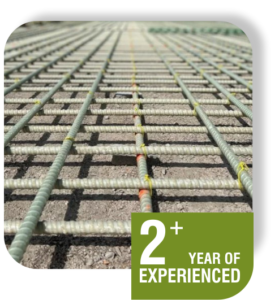Introduction
When it comes to modern construction, durability isn’t just a buzzword; it’s a necessity. As builders and engineers face the challenge of creating structures that can withstand the test of time, especially in harsh environments, the materials we use become critically important. Enter Glass Fiber Reinforced Polymer (GFRP) rebars—a revolutionary solution that’s changing the game by addressing some of the most pressing challenges in construction today. But what makes GFRP rebars so special? And why are they increasingly seen as the answer to durability concerns in environments where traditional materials fall short? Let’s explore.
The Durability Challenge: Why Traditional Materials Fall Short

In construction, particularly in areas exposed to aggressive environmental conditions, traditional steel rebars have long been the go-to choice for reinforcement. However, steel comes with a significant flaw—its susceptibility to corrosion. Think about structures in coastal areas, where saltwater spray relentlessly attacks steel, leading to rust and, eventually, structural degradation. Or consider chemical plants where steel rebars are exposed to corrosive substances daily. Even in cold climates, where freeze-thaw cycles can cause repeated expansion and contraction, steel doesn’t hold up well over time.
This ongoing battle with corrosion and environmental wear means that structures often require extensive maintenance or even premature replacement, leading to increased costs and environmental impact. The need for a more durable solution that can withstand these harsh conditions without compromising on strength and longevity is evident. That’s where GFRP rebars step in as a superior alternative.
Why GFRP Rebars? The Science Behind the Superiority

Corrosion Resistance:
At the heart of GFRP’s durability is its remarkable resistance to corrosion. Unlike steel, GFRP rebars don’t rust when exposed to moisture, chemicals, or saltwater. This makes them an ideal choice for construction in coastal regions, chemical plants, and other corrosive environments. Imagine a bridge exposed to saltwater day in and day out—GFRP rebars ensure that the bridge remains strong and safe without the worry of rust weakening the structure over time.
High Strength-to-Weight Ratio:
GFRP rebars are impressively strong yet incredibly lightweight. This dual advantage reduces the overall weight of the structures, making transportation and installation easier and more cost-effective. You get the strength needed to support massive concrete structures without the burden of excessive weight—a win-win for modern construction projects.
Thermal Stability:
Harsh environments often come with extreme temperature fluctuations, which can wreak havoc on traditional materials. GFRP rebars, however, maintain their structural integrity even in these conditions. Whether it’s the blistering heat of a desert or the freezing cold of the arctic, GFRP rebars continue to perform without significant degradation.
Non-Conductive Properties:
In structures where electromagnetic interference is a concern—such as hospitals, airports, or power plants—GFRP rebars are the perfect solution. They don’t conduct electricity, adding an extra layer of safety and reliability to the construction.
Real-Life Applications: Proving Durability in the Field
Coastal and Marine Structures:

Coastal environments are some of the harshest on structures, thanks to constant exposure to saltwater and high humidity. Traditional steel-reinforced concrete in these areas often shows signs of corrosion and weakening within a few years. However, GFRP-reinforced structures, like bridges and piers, have proven to stand the test of time, showing minimal signs of degradation even after decades of exposure. This not only extends the life of the structure but also significantly reduces maintenance costs.
Chemical Plants and Industrial Settings:
In industrial settings, particularly chemical plants, the environment can be highly corrosive. Tanks, pipelines, and other critical infrastructure in these plants must withstand continuous exposure to aggressive chemicals. GFRP rebars have been used in these settings with great success, providing a long-lasting, maintenance-free solution that ensures safety and structural integrity.
Infrastructure in Extreme Climates:
Cold climates present a unique challenge to construction materials due to the freeze-thaw cycles that cause expansion and contraction, leading to cracking and weakening. In such regions, GFRP rebars have demonstrated superior performance, particularly in roads, bridges, and tunnels. The resilience of GFRP to these temperature fluctuations ensures that infrastructure remains strong and safe, reducing the need for frequent repairs and replacements.
The Bigger Picture: GFRP Rebars as a Sustainable Solution

When we talk about durability, we’re not just talking about longevity; we’re also talking about sustainability. A material that lasts longer reduces the need for frequent repairs and replacements, which in turn reduces resource consumption and environmental impact. GFRP rebars are not only durable but also more sustainable compared to traditional steel. Their production generates fewer greenhouse gases, and they are recyclable, making them a green choice for future construction projects.
Moreover, GFRP is unique in that it offers a rare combination of durability, economic efficiency, and sustainability—traits that are often hard to find together in one material. Most construction materials excel in two areas but fall short in the third. GFRP, however, breaks the mold by being the complete package, providing a long-lasting, cost-effective, and environmentally friendly solution that the construction industry desperately needs.
Conclusion: Embracing the Future with GFRP Rebars
The construction industry is at a crossroads, with the need for more durable, sustainable, and cost-effective materials growing more urgent every day. GFRP rebars represent a new era of construction—one where structures are built to last, even in the most challenging environments. By choosing GFRP rebars, we’re not just building stronger structures; we’re building a more sustainable and resilient future.
So, the next time you think about the longevity and sustainability of a project, consider GFRP rebars as your go-to solution. It’s not just about meeting today’s challenges; it’s about preparing for tomorrow’s demands, ensuring that the infrastructure we build today stands strong for generations to come.
Ready to learn more about how GFRP rebars can revolutionize your next project? Contact us today to explore how this innovative material can enhance the durability, sustainability, and economic efficiency of your construction endeavors.
